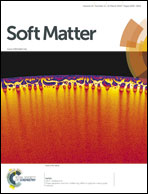Self-assembled polymersomes formed by symmetric, asymmetric and side-chain-tethered coil–rod–coil triblock copolymers
Abstract
Self-assembly behaviors of coil–rod–coil copolymers in selective solvents are explored by dissipative particle dynamics. The morphological phase diagram as a function of rod length and coil length shows five distinct types of aggregates, including spherical micelles, worm-like micelles, disk-like aggregates, honeycomb structures, and polymersomes. Small polymersomes are formed at rather poor alignment associated with monolayered rod domains. Some of the rods are even lying perpendicular to the radial direction. For symmetric copolymers (CmRxCm), the condition of vesicle formation is restricted to short coil and rod lengths. To favor the formation of CRC-polymersomes, two architecture modifications are adopted. One is to increase the coil length asymmetrically to be CmRxCn, where n > m. The other one is to tether a T-block onto the middle of the rod-block as Cm(RxTy)Cm copolymers. For those CRC-polymersomes, structural, transport, and mechanical properties of the vesicular membrane are determined, including membrane thickness, area density of coil blocks, order parameter, solvent permeability, frequency of flip-flop, membrane tension, and stretching and bending moduli. The influences of the coil length (n) and tethered block length (y) on membrane properties are examined. Finally, the mechanism of membrane fusion between CRC-polymersomes is investigated. The fusion process involves four stages and in the contact region the rods lying perpendicular to the radial direction of the polymersome play the key role. The encounter of two vesicles may result in a fused, hemifused, or non-fused polymersome. The final fate is determined by the competition between membrane tension and the steric barrier of the coil corona. The fusion outcome may change if the tension is altered by manipulating the lumen pressure.


 Please wait while we load your content...
Please wait while we load your content...